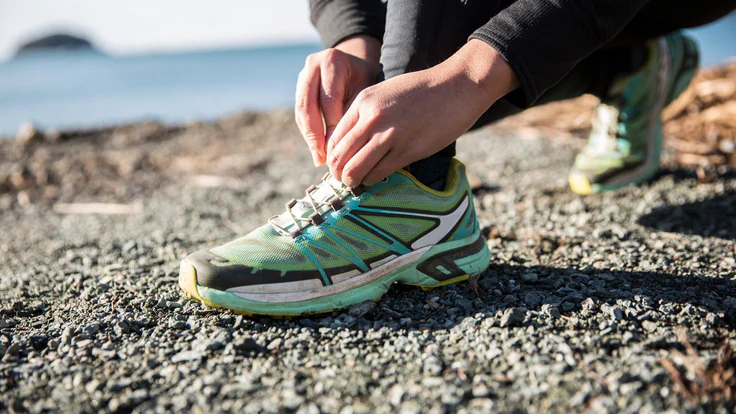La guida definitiva alla terminologia delle scarpe da running: comprendi le caratteristiche chiave per una calzata perfetta.

Ferri dietro. Pronazione. Parte superiore...oh mio! Quando si tratta di acquistare scarpe da corsa, decodificare la terminologia può essere più difficile che trovare il paio perfetto e adattabile, alla Cenerentola. Lavorare con un professionista di una negozio specializzato in scarpe da corsa può evitare la necessità di conoscere il gergo. Tuttavia, se si acquistano scarpe online, o semplicemente si cerca di educarsi sui termini tecnici, ecco una guida con tutto ciò che si deve sapere per camminare (o...parlare) del linguaggio delle scarpe da corsa.
La pronazione descrive il modo in cui il piede si arrotola per la distribuzione dell'impatto durante la camminata o la corsa. Ci sono tre modi diversi per categorizzare questo processo:
Di solito, la pronazione viene osservata durante una valutazione di scarpe da corsa in un negozio specializzato su un tapis roulant, così che un professionista esperto possa vedere come si cammina o si corre e si atterra sui piedi.
Potresti pensare che qualsiasi tipo di pronazione sia una cosa negativa; dopotutto, i corridori tendono a lamentarsi del proprio passo specifico e dei suoi dolori e fastidi associati. Ma la pronazione è un processo naturale che è altamente individuale e semplicemente spiega il modo in cui il tuo corpo si muove. Non c'è nulla che 'abbia bisogno di essere corretto' o 'giusto o sbagliato' - ma piuttosto ci sono modi in cui le scarpe possono ottimamente adattarsi e supportare i tuoi piedi e il tuo passo. "Solitamente dico ai miei corridori di non preoccuparsi troppo della forma a meno che non ci sia un problema cronico che stanno continuamente risolvendo - se non è rotto, non ripararlo", dice John Honerkamp, allenatore di corsa certificato RRCA e USATF. "Vedo troppi corridori che cercano di 'perfezionare' la loro forma solo per creare più infortuni. Uno dei miei più grandi fastidi è quando vedo corridori cercare di correre sulle punte dei piedi perché il loro medico dice loro di non atterrare con il tallone. Io dico di atterrare sul tallone se funziona per te".
Ma se sei spesso bloccato dagli infortuni, può essere utile conoscere meglio il tuo passo. "Se hai sempre a che fare con infortuni, è molto più importante capire come i tuoi piedi si comportano quando corri", spiega Honerkamp. "Diventi un detective e ti concentri su tutti i particolari della sovra-pronazione o sottopronazione e tutto ciò che si trova in mezzo. La maggior parte dei corridori pronerà in qualche misura poiché è la forma naturale del tuo corpo assorbire gli urti".
Supporto si riferisce esattamente a ciò che sembra. Descrive come la scarpa aiuta a fornire correzione strutturale, ammortizzazione e stabilità ai tuoi piedi. Il supporto stesso può essere suddiviso in due sottocategorie: scarpe neutre e scarpe stabili. La differenza principale tra questi tipi di scarpe è il loro livello di supporto e la quantità di correzione per il piede.
In termini tecnici, l'ammortizzazione si riferisce all'assorbimento degli urti fornito dalla suola intermedia della scarpa, anche conosciuta come l'imbottitura del mezzo strato della scarpa sotto il piede ma sopra la suola. Esistono tre diverse categorie: minimalista, moderata e massimalista.
Stai ancora cercando di capire che tipo di scarpa soddisfa le tue esigenze? "Se hai un arco alto, sei più propenso a stare bene con una scarpa neutra e anche le scarpe minimaliste. L'utilizzo di una scarpa minimalista può anche essere utile per aiutare a rafforzare i tuoi piedi poiché richiedono più lavoro dal tuo piede e meno dipendono dalla scarpa", spiega Honerkamp. "L'ammortizzazione moderata e massima entrano in gioco se cerchi un'esperienza più assorbente agli urti. Sceglierò scarpe più ammortizzate se i miei piedi o i miei talloni iniziano a ferirsi quando corro. Opterò anche per una scarpa più ammortizzata se corro su asfalto, marciapiedi o strade invece che su un bel sentiero morbido".
Anche conosciuto come 'caduta' o 'differenziale', la caduta dal tallone alla punta (differenziale HTT) è la differenza di altezza tra il tallone e la pianta del piede di una scarpa da corsa. Un altro modo per pensare ad esso è la pendenza dal tallone alla punta, o un confronto tra la quantità di ammortizzazione sotto il tallone e la quantità di cuscinetto sotto le dita dei piedi. La caduta dalla punta al tallone influenza la forma di corsa influenzando la meccanica del passo del corridore.
La responsività descrive quanto velocemente ed efficientemente una scarpa ritorna energia al corridore durante la sua corsa. Una scarpa più sensibile fornisce una sensazione di elasticità e sospensione, risultando in meno fatica e sforzo. Questa spinta nel passo è influenzata da una combinazione di materiali utilizzati per creare la suola, dal sistema di ammortizzazione e dal design generale della scarpa. Se si cerca una scarpa più sensibile, si vuole qualcosa con schiuma a metà suola o suola ferma.
È importante notare che la responsività di solito è un compromesso con l'ammortizzazione e la stabilità. Scarpe super attive possono avere meno stabilità, il che non è sempre fantastico, soprattutto per coloro che necessitano di maggior supporto o di una maggiore assorbenza degli urti come i corridori principianti o quelli con una storia di dolori articolari e muscolari.
The physical mass of a shoe, or the shoe weight, influences comfort, injury risk, and performance. The higher the weight of a shoe, the more energy is required from a runner (think: slower time and increased fatigue). The lighter the shoe, the more effortless and quick you may feel. Cushioning and stability design features may weigh a bit more, but they provide necessary injury protection and comfort.
The upper, or the top part of the shoe that covers the foot, plays an incredibly important role for overall shoe fit (but doesn't typically get a lot of love). This key feature holds the foot in place, providing a snug, custom fit that carries you (and the shoe) for miles. There are four key factors you'll likely want to consider with the upper: breathability, durability, flexibility, and fit.
Heel counter is the name for the piece of material at the back of a running shoe that supports the heel and ankle. It enhances the fit of a shoe and prevents excessive pronation and supination. Runners who struggle with plantar fasciitis or shin splints may want to choose shoes with a solid heel counter.
Important for traction, cushioning, and support, the sole of a running shoe is the bottom part that contacts the ground. Soles for running shoes are made from different materials. The sole you select is usually related to the use case of the shoe. For example, a rubber sole has excellent traction and grip, making it perfect for running on a variety of surfaces. A carbon fiber sole is very lightweight and strong, but has very little cushioning, making it most ideal for competitive, shorter-distance runners.
Foam soles are typically used in many running shoes. Ethylene-Vinyl Acetate (EVA) foam is lightweight, flexible foam (usually used in the midsole), whereas polyurethane (PU) foam is denser, providing more stability and support. Highly responsive shoes typically use thermoplastic polyurethane (TPU plastic) in the mid or outsole.
The toe box is exactly what it sounds like. It's the front part of the shoe where the toes go. It serves a very important purpose: It allows the toes to flex during the running stride. While the size and fit of a toe box are highly individual (some people prefer a snug fit, while others love to wiggle their piggies in a roomy toe box), finding the right size can improve overall foot function in the shoe and cut down on injury. A cramped and narrow toe box may result in calluses, bunions, and blisters, whereas a toe box that's too big may have you feeling like you're sliding around.
The tongue of the shoe is the part below the laces and on top of the instep (and between the upper and the foot) that looks similar to it's name. The purpose is to protect the feet from the laces and enhance the fit and comfort of a shoe. If you're looking for comfort, choose a thicker tongue. However, if you're not into the super-cushiony, padded feeling, a slim tongue that fits flush against your foot can offer a more aerodynamic feel.
The toe spring is a key design feature in a running shoe that causes an arch in the forefoot of the shoe. This arch allows for a smoother transition in your stride, particularly as the foot rolls forward and pushes off the ground. The natural shape mimics a foot's contour and improves the efficiency of a runner's gait. Some runners may not like the extra spring in their step, however, the toe spring does reduce the amount of stress on the metatarsal bones and toes, which can be helpful for those who have frequent foot or toe pain.
The medial post is the part of the running shoe that provides additional support on the inside (AKA medial) side of the foot. It helps to control overpronation (that is, when the foot rolls inward), improving foot stability and reducing the risk of injuries associated with overpronating, including plantar fasciitis, shin splints, and knee pain.
A sockliner (AKA insole) is the fancy term for the insert that provides an extra layer of support and cushioning on the interior of the shoe. In most simple terms, it's the part you take out when you put in your own orthotic.
Heel crash pads are helpful to improve cushioning for runners with a heel-toe gait. They maximize the efficiency of the foot landing, particularly during the heel strike phase of the stride. This shock absorber is great for runners who train mostly on hard surfaces like asphalt or concrete and is typically found in maximal shoes (AKA those with very thick midsoles). In simplistic terms, it's like an extra bouncy pad underneath your heel.




